In another incredible week of midsummer rarities, Britain's first Soft-plumaged Petrel sits snugly at the top of another long list of highlights. Tracked along the coast between Flamborough Head, East Yorkshire, and Stag Rocks, Northumberland, it was picked up at 12 sites along its journey, including in North Yorkshire, Cleveland and Durham. It is told from its close North Atlantic relatives (Fea's, Zino's and Desertas Petrels) by its complete breast band, while it also shows small whitish L-shaped inner forewing patches and a characteristic upward-pointed dark mark in front of the eyes.

Soft-plumaged Petrel, Newbiggin-by-the-Sea, Northumberland (John Graham).
Just a third record for the Western Palearctic, it follows one off Finnmark, Norway, on 6 June 2009 – the only other record anywhere in the North Atlantic – while the first was off Eilat, Israel, and Aqaba, Jordan, on 25 March 1997. Meanwhile, the first Fea's-type petrel of the year was noted off the Cornish coast on 28th.
Just shy of a year to the day of its last appearance at Bempton Cliffs RSPB, East Yorkshire, on 2 July 2020, the adult Black-browed Albatross reappeared there from 28th, noted passing low along the cliff edge at Thornwick Bay during the evening. Present until late on 30th, it spent much of the time cruising at close range along the clifftops, providing some of the best-ever views of the species in Britain – it even managed a spot on BBC's Countryfile! Elsewhere, an albatross species was reported past Cape Clear, Co Cork, on 3rd, while a possible flew over a Farne Islands boat towards Staple Sound the next day.

Black-browed Albatross, Bempton Cliffs RSPB, East Yorkshire (Alan Curry).
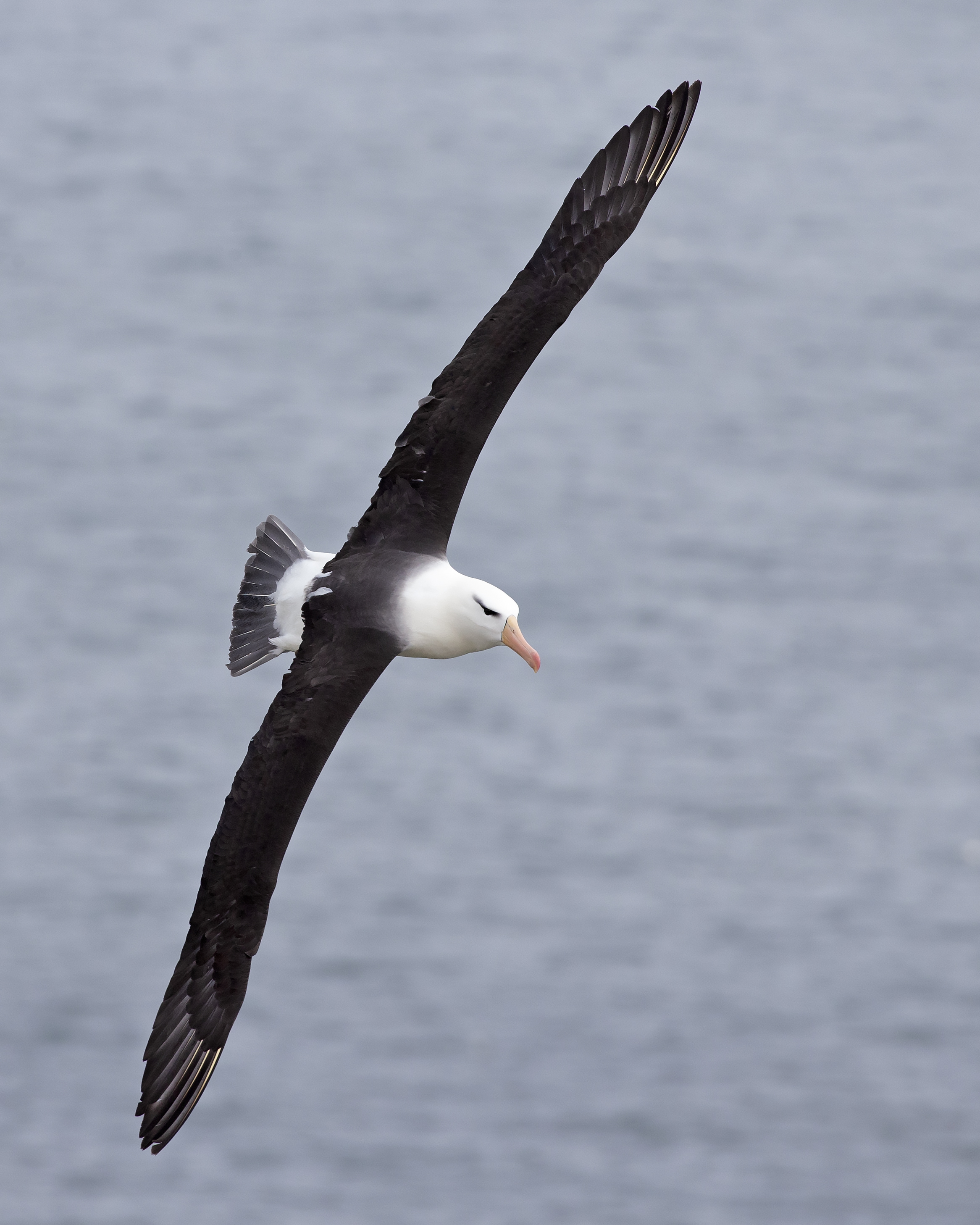
Black-browed Albatross, Bempton Cliffs RSPB, East Yorkshire (Sam Viles).
An Oriental Turtle Dove of the Central Asian meena subspecies was something of a shock in gardens at Easington, East Yorkshire, from 2nd. Typically a vagrant of the late autumn and winter months, it is unsurprisingly the first July record for Britain – and the second for the Spurn recording area, after one in November 1975. There are a further two Yorkshire records: one shot at Scarborough, North Yorkshire, in October 1889 and another at Crigglestone, West Yorkshire, in March 2017, the former of the orientalis subspecies.

Oriental Turtle Dove, Easington, East Yorkshire (Andy Hood).
As the week ended, an Elegant Tern was picked out among the Sandwich Tern colony at Cemlyn Bay, Anglesey. The second Welsh record, it follows one at Black Rock Sands, Gwynedd, in July 2002. Interestingly, photo analysis suggests that it is likely to be one of the three mature birds from Polder de Sébastopol, Barbâtre, France, present between 19 and 27 June. The other two are still there, paired up and raising two chicks in a large colony of Sandwich Terns and Mediterranean Gulls (see here). The male of the pair is known as 'Bird C' and has visited Britain in the recent past, appearing at a number of sites in southern England in June 2017.

Elegant Tern, Cemlyn Bay, Anglesey (Stephen Tomlinson).
Elegant Tern, Cemlyn Bay, Anglesey (Mike Barth).
The fourth Short-billed Dowitcher for Ireland – a first-summer – was a fine find at Ring Estuary near Clonakilty, Co Cork, on 3rd. It remains a much rarer bird than its Long-billed cousin, although the most recent was at Dundalk, Co Louth, between September and November 2019.

Short-billed Dowitcher, Clonakilty, Cork (Ronan Archibald ).
News of Ireland's fourth and fifth Baillon's Crakes came to light this week; one was sound-recorded over Buckroney, Co Wicklow, on 24th while another sang for two weeks at an undisclosed locality earlier this summer. A singing male spent also three days at Alkborough Flats, Lincolnshire, from 5-7 June. How many more must be out there?
The male Least Tern spent another week at Portrane Point, Co Dublin, seeming enamoured with a particular female Little Tern. One would imagine any potential hybrids could cause real headaches in future summers, both across Ireland and further afield …

Least Tern, Rush, Dublin (Paul Lynch).
A Gull-billed Tern was at Hayle Estuary, Cornwall, on 28-29th, with the first-summer Bonaparte's Gull still in Shetland at Norwick, Unst.

Gull-billed Tern, Hayle Estuary, Cornwall (Martin Webb).
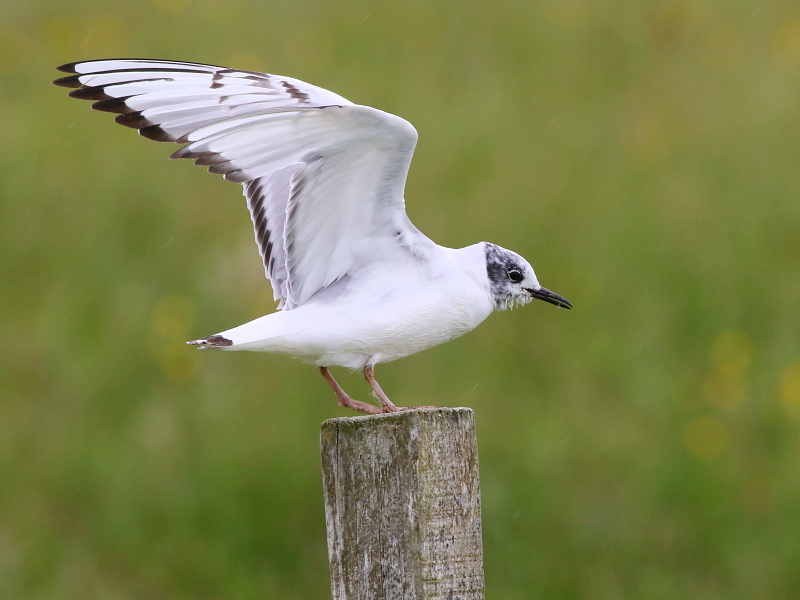
Bonaparte's Gull, Norwick, Unst, Shetland (David Cooper).
Two Caspian Terns at Southfield Reservoir, East Yorkshire, made regular jaunts to nearby Sykehouse, South Yorkshire, throughout. The younger of the two was again at Barton-upon-Humber Pits, Lincolnshire, on 28-29th. The Finnish-ringed second-summer was last noted at Llanelli Wetland Centre WWT, Carmarthen, on 29th, before resurfacing at Fairburn Ings RSPB and St Aidan's RSPB, West Yorkshire, on 2nd. Detective work found that it was ringed as a nestling at Hamina, Kymi, Finland, on 27 June 2019 – and that these were the first sightings anywhere since then.

Caspian Tern, Southfield Reservoir, East Yorkshire (Paul Coombes).
The purple patch at Hickling Broad, Norfolk, continued this week when a pristine adult Pacific Golden Plover was discovered on 3rd. Present briefly the next morning, it soon made a quick exit north. It perhaps didn't go far – it or another was at Cley Marshes that same evening.
An unconfirmed Collared Pratincole was reported from Rhosneigr, Anglesey, on 25th, while a possible Black Stork headed over Chatsworth Estate, Derbyshire, on 28th.

Pacific Golden Plover, Hickling Broad, Norfolk (Andy McGuinness).
Suffolk's European Roller remained a popular customer at Icklingham until 1st, after which there was no further sign.

European Roller, Icklingham, Suffolk (Terry Laws).
Gloucestershire's White-spotted Bluethroat was last noted at Slimbridge WWT on 2nd; Nottinghamshire's Great Reed Warbler at Besthorpe NWT, on the other hand, was there throughout – although proved highly elusive. In Wiltshire, a Savi's Warbler sang at Cleveland Lakes, Cotswold Water Park, on 1st.
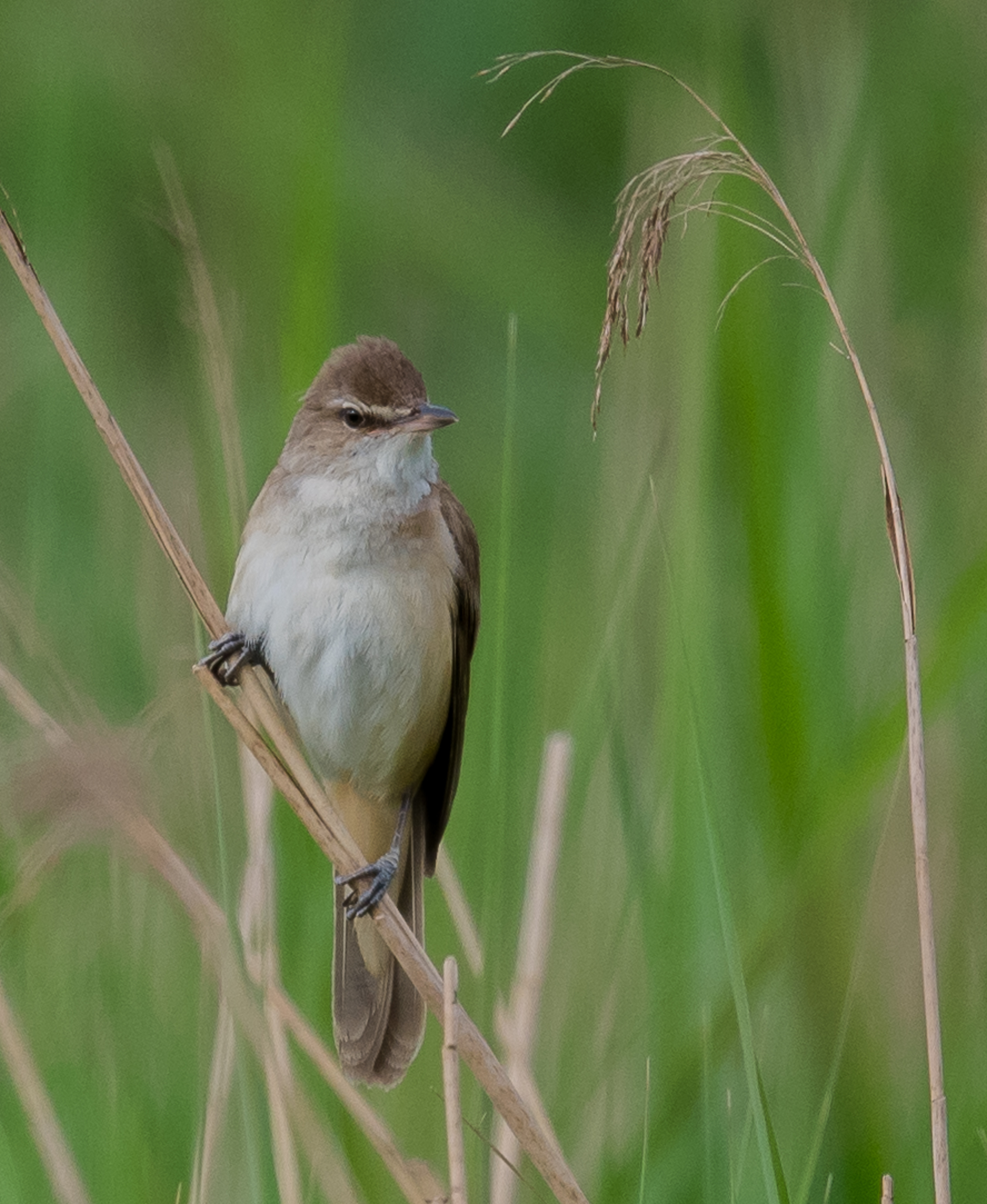
Great Reed Warbler, Besthorpe NWT, Nottinghamshire (Graeham Mounteney).
In Shetland, the male Snowy Owl was again at Ronas Hill, Mainland, on 26th; the Outer Hebrides female was again at Hirta, St Kilda, on 29th.
The young drake King Eider remained around mussel beds off Baltasound, Unst, Shetland, the drake Black Scoter was still off Blackdog, Aberdeenshire, until 1st, and the Pied-billed Grebe held out at Loch Feorlin, Argyll.

Black Scoter (centre), Blackdog, Aberdeenshire (Nick Littlewood).

King Eider, Baltasound, Unst, Shetland (Robbie Brookes).
The Walrus got himself into even more trouble this week on St Mary's, Scilly, where a newly formed 'Walrus Emergency Management Stakeholder Group' has secured permission from Natural England to play recordings of Polar Bear vocalisations in an attempt to dissuade the animal from hanging around in the harbour. He has recently sunk a local creel boat, as well as several RIBs and smaller boats. Elsewhere, the Sei Whale remained off Kinghorn, Fife.

Walrus, St Mary's, Isles of Scilly (Kris Webb).
Scottish mainland
A male Common Rosefinch at Craigie, Perth and Kinross, would have proved undoubtedly popular if it had lingered, as would the singing male Corncrake belatedly reported at Deans, Lothian, on 28th. In Ayrshire, a European Honey Buzzard overflew Prestwick Oval on 3rd.
No fewer than nine Rosy Starlings were noted this week, with four of these on islands – at Staffin Bay, Skye, Highland, and in Argyll at Caolas, Tiree, Salen, Mull, and Bruichladdich, Islay. Others were at Hamilton, Clyde, Wick and Thurso, Caithness, and Oldmeldrum and Loch of Strathbeg RSPB, Aberdeenshire
Notable for July, a White-billed Diver was at Sandside Bay, Caithness, on 1st, while an early Cory's Shearwater flew south past White Sands Bay, Lothian, on 30th. An adult Yellow-legged Gull was at Gourock, Clyde, on 3rd, with two Red-necked Grebes still in Gosford Bay, Lothian.
On Tiree, Argyll, a returning Curlew Sandpiper was at Miodar on 30th, with a Little Stint at Crossapol on the same date. An immature Eurasian Spoonbill held on at Loch of Strathbeg RSPB, Aberdeenshire, and five singing Common Quail were noted – at Sheriff Muir, Forth, Balmore Pool, Clyde, and Tarbolton, Ayrshire, with two at Fail Loch.

Long-tailed Duck, Coatbridge, Clyde (David Gibson).
Northern Isles and the Hebrides
The adult Long-tailed Skua continued at Loch of Clumlie, Mainland Shetland, for another week. A Glaucous Gull was at Noss, Mainland, on 28 June, while a Sooty Shearwater was logged from the Foula Ferry off Walls on 29th. The Greater Short-toed Lark only lingered at Lamba Ness, Unst, until 29th and a Rosy Starling was at Mid Yell, Yell, on 1st.
Fair Isle also hosted a Rosy Starling on 2nd but was otherwise quiet, with Marsh and Wood Warblers serving as best of the rest.
Mainland Orkney was quiet but hosted two Rosy Starlings: one at Dounby on 1st, while the Toab bird lingered until at least 3rd. The adult remained in-situ on North Ronaldsay on 27th and proved their sighting of the week.
The Outer Hebrides was also kept ticking over by Rosy Starlings, with four localities supporting birds: singles were at Eoligarry, Traigh Mhor and Brevig (all Barra), with another at Traigh Bhialais, Vatersay. A Pectoral Sandpiper was a sign of the forthcoming autumn on St Kilda on 29th.
Dan Owen
North-East England
Apart from a certain northbound seabird it was a relatively quiet week in Northumberland. Two Spotted Redshanks remained at Druridge Pools, where there was an unseasonal Jack Snipe. East Chevington NWT produced a Black Tern on 1st and 4th, with the Long Nanny individual still in place . A Ruddy Shelduck was at Castle Island on 28th with it or another seen flying over Newbiggin-by-the-Sea and at Hauxley NR later in the week. A Pomarine Skua flew past Cullernose Point on Thursday evening and a Common Quail was seen at St Mary's Island (another was sound-recorded over Upper Tweedmouth in the early hours of 2nd).

Black Tern, Beadnell Bay, Northumberland (Lynn Griffiths).
Three Pomarine Skuas flew past Whitburn Coastal Park, Durham, during the week, along with a Long-tailed Duck, four Velvet Scoter and a Spotted Redshank. A Garganey was at Rainton Meadows DWT on 4th. In Cleveland, a Pectoral Sandpiper was reported at Saltholme RSPB on 1st and a Eurasian Spoonbill also lingered on the reserve. A female Long-tailed Duck spent two days in Hartlepool.
Jonathan Farooqi
North-West England
Belated news of two Roseate Terns in the tern colony at Hodbarrow RSPB, Cumbria, on 28 June might offer a glimpse into the future. A drake Velvet Scoter was off South Walney RSPB on 30th. Lancashire also hosted a Roseate Tern at Seaforth LWT on 3rd, and a Velvet Scoter off Starr Gate, Blackpool the same day. Wood Sandpipers started their return migration, with four sites scoring.
Cheshire was quiet, but Burton Mere Wetlands held two Wood Sandpipers on 2nd, alongside Garganey, Eurasian Spoonbill and up to nine Spotted Redshanks. Meanwhile, news of up to 15 juvenile Black-necked Grebes still at Woolston Eyes NR was welcome news.
Dan Owen
Lincolnshire and Yorkshire
A brief Montagu's Harrier was at Messingham Sand Quarry, Lincs, on 2nd, with the Glossy Ibis again at Branston Island on 28th. Other news included a few Wood and Curlew Sandpipers, plus Common Quail still in song near Scopwick. Rather unseasonal was a Russian White-fronted Goose at Deeping Lakes LWT on 29th.

Eurasian Spoonbill, Frampton Marsh RSPB, Lincolnshire (Jeremy Eyeons).
In East Yorkshire, a brief Rosy Starling was at Brough Airfield Marsh on 30th. An Icterine Warbler sang at Kilnsea on 29th, with a Grey-headed Wagtail seen again on 2nd and a European Nightjar on 28th. A Black Guillemot flew past Long Nab, North Yorkshire, on 29th, with an unusual midsummer record of Red-breasted Merganser coming from Bolton-on-Swale Lake YWT on 28th.
A couple of West Yorkshire sites held Common Scoter, with at least three localities producing Wood Sandpipers.
Josh Jones
West Midlands
A Little Tern at Blithfield Reservoir on 30th was Staffordshire's pick of the bunch. A drake Garganey was at Marsh Lane NR, West Midlands.
A ringtail harrier at Maxstoke, Warwickshire, initially proved a head scratcher on 29th, before the ID was crystalised as a Montagu's Harrier – arguably the most exciting option these days. A Little Tern paid a brief visit to Ladywalk NR on 28th, when a Black Tern flew east over Middleton Lakes RSPB.
In Worcestershire, two Black Terns passed through Clifton Pits on 3rd, before relocating to Camp Lane Pools, Grimley. The former site had a pair of Wood Sandpipers on 29-30th. Another was heard overflying Worcester on 2nd.
Dan Owen
East Midlands
Three drake Greater Scaup at Long Eaton GPs, Derbyshire, on 2nd were a tad unusual for early July. Similar could be said about the Arctic Tern present at Foremark Reservoir on 1st, while the two Ruddy Shelduck continued to delight at Carsington Water throughout.
A Little Tern was at Collingham Pits, Notts, on 2nd; two Sandwich Terns flew over Holme Pierrepont the same morning. Three Black Terns graced Idle Washlands on 28th, alongside a first-summer Little Gull, while another was at Kilvington Lakes the same day and one at Attenborough NR on 30th. In Northants, a Wood Sandpiper was at Stanwick GPs on 28th. Up to two first-summer Caspian Gulls were using the pools at the DIRFT 3 development site near Lilbourne.
Rutland Water - some sound recording of the Icterine Warbler today - a great find by @Lufbrabirder and Terry Sherwood. 2nd county record. @birdguides @LROSbirds pic.twitter.com/Whxc0J7nhh
— Stanford Birder (@c4hub) June 29, 2021
Another week and another great inland warbler, this time a surprise Icterine Warbler was singing away at Rutland Water on 29th – just the second county record – although proved difficult to see. The first-summer Black Tern remained on offer throughout, and was joined by an adult on 29th, while a Wood Sandpiper was also present on 4th. Ullesthorpe hosted a Rosy Starling on 4th.

Rosy Starling, Ullesthorpe, Leicestershire and Rutland (Christopher Brinklow / Ann Karin Solheim).
Dan Owen
East of England
In Norfolk, the nine European Bee-eaters were seen again, flying over Cromer on 2nd, Sheringham on 3rd and Happisburgh on 4th. Further groups of at least four were over Heacham on 4th, two over Mautby on 4th and one over Stiffkey on 2nd. A Red-necked Phalarope at Salthouse on 28th moved to Cley Marshes the following day. A new Rosy Starling was at Weeting on 3-4th, with a brief Red-backed Shrike at Weybourne on 4th. The two Black-winged Stilts were still at Hickling Broad.

Red-necked Phalarope, Minsmere RSPB, Suffolk (Andrew Moon).
European Bee-eaters were also seen in Suffolk, with two over Iken on 2nd and one on wires at Walpole. The Purple Heron was still at Minsmere RSPB this week, with a Red-necked Phalarope there on 30-1st. The Glossy Ibis continued at Lackford Lakes SWT. Best bird in Essex was a Red-necked Grebe at Abberton Reservoir from 29th.

Eurasian Spoonbill, Boyton Marshes RSPB, Suffolk (Nick Brown).
Common Quail at Deadman's Hill, Wood Sandpiper at Stanborough Lakes and Black-necked Grebe at Tyttenhanger GPs were the most notable sightings from Hertfordshire. In Bedfordshire, up to three Caspian Gulls were at Grovebury Sand Pit, and a Common Quail sang at Maulden Wood on 1st. Two Black Terns near Longstanton on 29th and a singing Common Quail at Burwell were the best on offer in Cambridgeshire.
Josh Jones
South-East England
One of the more surprising records of the week was an Alpine Swift over Leatherhead, Surrey, on 30th, having been released there by Wildlife Aid after it was found exhausted not far away at North Cheam several days previously. The full story of this 10th for Surrey can be found here. An unringed White Stork at Rainham Marshes, London, got a bit of attention following its arrival and continued presence from 30th. Two Sandwich Terns were at London Wetland Centre on 28th.

Alpine Swift, Leatherhead, Surrey (Wildlife Aid Foundation / Abbey Warner).
A Red-necked Phalarope dropped in at Blashford Lakes, Hampshire, on the morning of 28th. A Roseate Tern was at Hill Head on 30th, Common Quail were at Horndean and Martin Down and the Pink-footed Goose continued at Fleet Pond. On the Isle of Wight, the Brading Marshes Purple Heron put in a couple of showings but remained elusive.
Berkshire scored Eurasian Spoonbill at Lea Farm GPs on 28th, while a Temminck's Stint visited Little Marlow GPs in Buckinghamshire the following day. A Rosy Starling was again at Wantage, Oxfordshire, on 2nd and 4th, with the Otmoor Glossy Ibis and Common Quail at Lowbury Hill (two) and Letcombe Bassett (three).

Eurasian Spoonbill, Lea Farm GPs, Berkshire (Roger Stansfield).
On the morning of 1st, a female Red-backed Shrike was an all-too-brief visitor to Ilford, East Sussex. Two Roseate Terns were at Church Norton and Newhaven, Common Quail were at Steep Down (two) and Amberley Wildbrooks and the Rye Harbour Black-necked Grebe continued. On 4th, the first reported juvenile Yellow-legged Gull of the season was at West Rise Marsh.
In Kent, there was a report of nine European Bee-eaters south over Sandwich Bay, as well as a European Honey Buzzard over Ramsgate. A probable Melodious Warbler was singing at Langdon Cliffs on 28th. Farthing Corner and St Margaret's at Cliffe hosted Common Quail and the Dungeness Glossy Ibis was still knocking about.
Ed Stubbs
South-West England
On St Mary's, Scilly, the Red-footed Falcon was still present throughout, along with the first-summer Iceland Gull. At least one Rosy Starling was sighted twice during the week. The singing male Marsh Warbler was still on St Agnes on 29th, and a Scilly pelagic scored a Wilson's Storm Petrel the previous day. A Dark-bellied Brent Goose was found on Bryher on 2nd and lingered for a couple of days.
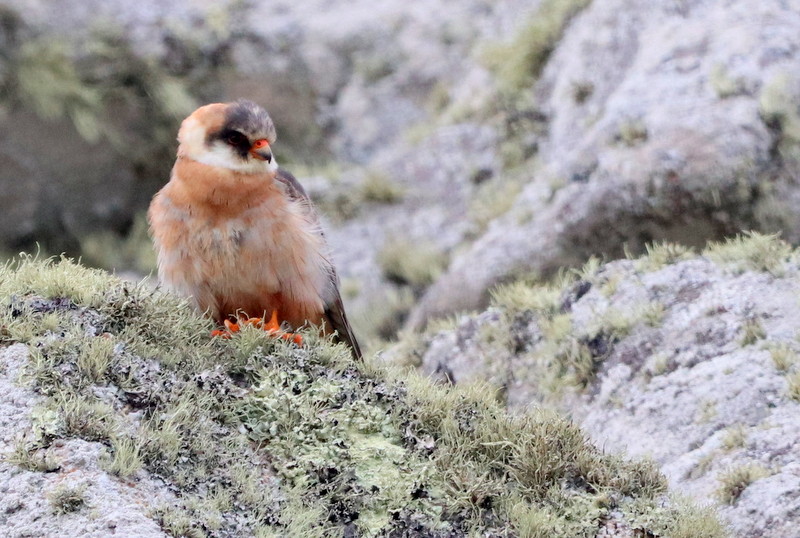
Red-footed Falcon, St Mary's, Isles of Scilly (Kris Webb).
A Wilson's Storm Petrel was seen from a boat south of Penzance, Cornwall on 30th. Late news emerged of a Black Kite over Porthgwarra on 18 June and three Pomarine Skuas flew past there over the weekend. Ruddy Shelduck were at Stithians Reservoir and Helston, with the latter site continuing to play host to the drake Greater Scaup.
In Devon, Wood Sandpipers were recorded at Exmimster Marshes RSPB, Soar and near Portworthy. Two Balearic Shearwaters flew past Start Point on 3rd, and a Great Northern Diver was off Dawlish Warren NNR the same day.
The singing male Melodious Warbler remained at Middlebere, Dorset, on 28th but had moved on by the following day. Further scarcities came in the form of a Black Kite over Studland Heath NNR on 2nd (the same individual as seen in Cornwall on 18 June), European Serin on Portland on 2nd and a European Honey Buzzard over Lytchett Bay on 20th. Roseate Terns were noted at Lodmoor RSPB and Abbotsbury Swannery, with the former locality also hosting singles of Eurasian Spoonbill and Wood Sandpiper. Balearic Shearwaters were seen off Portland on two dates and the male Common Quail continued to sing at Hartland Moor.

Melodious Warbler, Middlebere, Dorset (Jeremy Mcclements).
Two Black-winged Stilts remained at Pilning Wetland, Gloucestershire, until 1st. A European Honey Buzzard flew over Slimbridge WWT on 30th, where four Garganey and two Wood Sandpipers also lingered. Common Quail were at three localities.

Black-winged Stilt, New Passage, Gloucestershire (Hugh Gregory).
A Wood Sandpiper at Catcott Lows NR on 4th was the highlight of the week in Somerset. In Wiltshire, two Black Terns were at Cotswold Water Park on 28th. A Red Knot appeared at Langford Lakes on 30th and stuck around for a couple of days. Common Quail were at three sites in the county during the week.
Jonathan Farooqi
Wales
In a quieter week for Wales, a Rosy Starling spent the week at Rhos-on-Sea, Conwy, while a probable Black Kite flew north over Haverfordwest, Pembrokeshire, on 30th. Two Common Quail were noted – at Aberffraw, Anglesey, and Mynydd Illtud, Powys – although, unfortunately, a Black Redstart on Bardsey Island, Gwynedd, on 28-29th was found dead in a tool shed on 4th.
Two Roseate Terns remained at Cemlyn Bay, Anglesey, with a Western Cattle Egret at nearby Cors Ddyga RSPB on 30-1st. Goldcliff Pools, Gwent, held a Little Stint, and Hooded Crows were at Uwchmynydd, Gwynedd (two), and Rhyl, Clwyd.

Roseate Tern (right), Cemlyn Bay, Anglesey (Chris Jones).
Ireland
Four Rosy Starlings were noted in Co Kerry this week, with another still in Clifden, Co Galway, and singles in Cos Donegal and Antrim.
A lingering Curlew Sandpiper was still at Blanket Nook, Co Donegal, while a Wilson's Storm Petrel and a handful of Long-tailed Skuas from RV Celtic Explorer off the west coast hinted at the forthcoming seabird season.
Two blue-morph Snow Geese at South Slob, Co Wexford, on 29th are at best classed as of 'unknown origin'.
Western Palearctic
In a quieter week for the region, Iceland's singing male Black-and-white Warbler continued at Syðra Lágafell until 30th at least, while a Buff-breasted Sandpiper was photographed at Garður. A White-billed Diver at Kópasker is just the country's fourth record.
A new Pygmy Cormorant resided at Everdingen, The Netherlands, from 1st, the possible Stilt Sandpiper (arguably a Calidris hybrid) hung on at Twisk and an immature Bearded Vulture was still near Ede. A Western Swamphen remained near Gletterens, Switzerland.
On 1st, an Eastern Imperial Eagle flew over Vainikkala, Finland, towards the Russian border, with the nation's seventh White-tailed Lapwing was at Otanmäki on 29th. A smart male Lanceolated Warbler reeled at Parikkala.
The White-throated Swallow was again at Sakaka, Saudi Arabia, on 3rd; a Lesser Crested Tern was at Cádiz, Spain, on 4th. In France, four Elegant Terns (two adults and two chicks) continued at Polder de Sébastopol, Barbâtre, throughout.
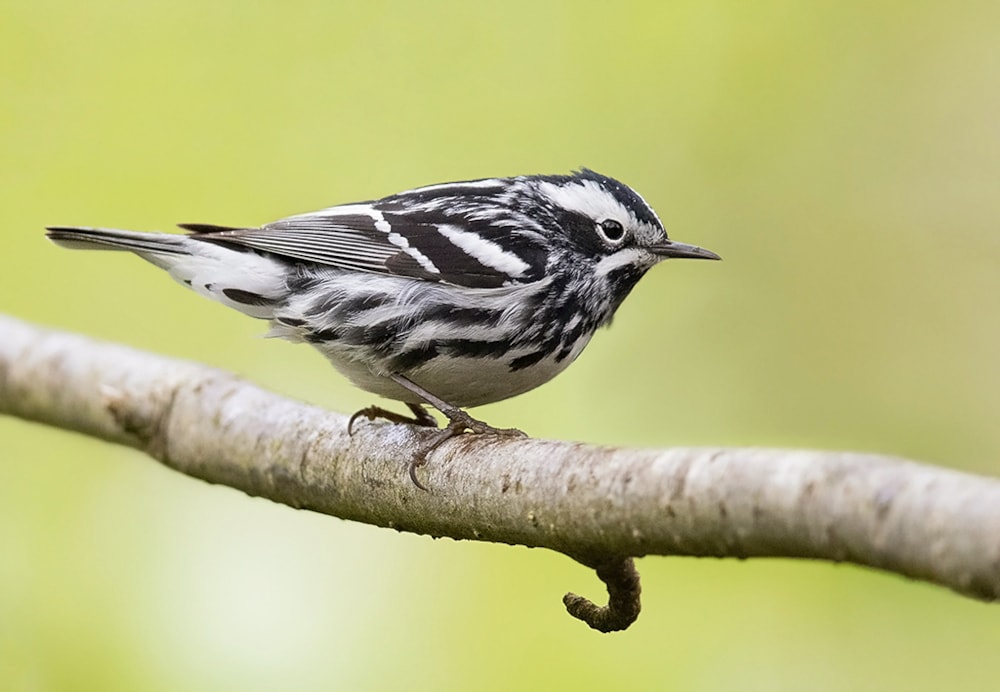
Black-and-white Warbler, Lágafell, Snæfellsnes, Iceland (Alex Máni Guðríðarson).

